Do-it-yourself heat gas gun: step-by-step assembly instructions
There are various options for heat guns on the specialized market.They differ in brands, fuel used to operate the unit, dimensions, design and price. However, the cost of branded heat guns often repels buyers.
If you have metal processing skills, you can build a budget unit yourself. After all, a thermal gas gun is assembled with your own hands from inexpensive materials. Such a unit is capable of heating a small garage or providing the proper microclimate in a greenhouse.
Do you doubt your own abilities? We will help you realize your plans. The article describes in detail the design features, operating principles and operating nuances of various gas guns. Step-by-step instructions for manufacturing and launching the device are also provided.
The content of the article:
Scope of application and principle of operation
The operating principle of such a unit can be compared to the operation of a fan, however, the heat gun releases warm air into the room rather than cold.
The air operating inside the housing is heated by heating elements or burners operating on various types of fuel.
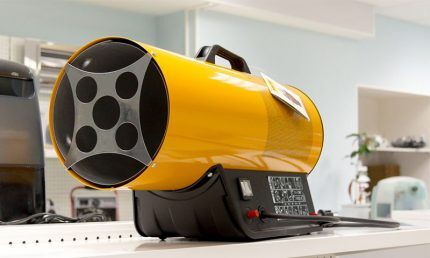
Heat guns of various modifications find a wide range of applications.
They are successfully used:
- in industry for heating large production and storage facilities;
- in agriculture to maintain comfortable air temperature in greenhouses, greenhouses, greenhouses;
- in construction for quick drying of plastered, painted or otherwise finished rooms;
- in everyday life for heating and drying utility rooms and garages;
- for heating residential buildings in emergency circumstances (for example, accidents on heating routes).
There are other ways to use such devices, for example, gas units are widely used when installing suspended ceilings.
Types of heat guns
There are several types of classification of thermal heaters.
They are most often distinguished:
- according to the design of the heating element - heating method;
- by type of fuel used as a heat source.
In addition, devices can also be divided according to purpose of use into industrial and household.
Classification by heating method
Although all heat guns are used to increase the temperature in a room, depending on the design of the model, the process can be carried out differently.
Devices with direct (direct) heating
In such devices, a powerful fan takes air from the environment. Due to direct contact with the heating element, the air mass acquires a high temperature, after which it is “thrown out” into the room through a special hole.
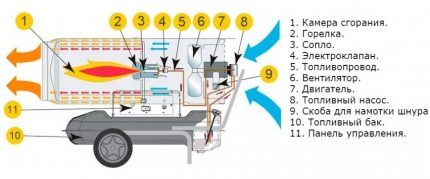
Such units are relatively low cost and have solid efficiency, but they lack environmental friendliness. All the resulting combustion products escape into the atmosphere, which can be not only unpleasant, but also dangerous for people in the room.
To prevent this from happening, the rooms where such devices are used must be regularly ventilated or, which is much better, forced ventilation must be organized in them.
Heat guns with indirect heating
Such devices have a more complex design, which includes a heat exchanger where heat is separated from harmful combustion products. The latter are sent to a special pipe connected to the chimney, through which the exhaust is discharged from the room to the street.
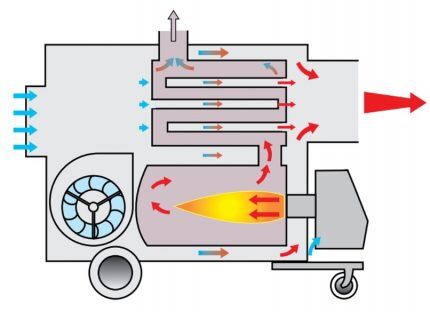
Although such devices are more expensive, and their efficiency is somewhat lower than that of devices with an open burner, they are still in great demand due to their environmental friendliness and safety in use.
The specific heat gun model should be selected taking into account the planned use. Options with direct heating are suitable for heating large uninhabited spaces (basements, warehouses).
If the device is intended to be used in rooms where people are present, for example, production workshops, it is better to choose models with indirect heating.
Division by fuel type
Taking into account the fuel on which the devices operate, the following types of heat guns can be distinguished:
- Electrical. Such units are environmentally friendly, they do not burn oxygen and do not emit harmful substances into the air, so they can be safely used for heating living rooms. The only downside is the rather high price of electricity.
- Multi-fuel — diesel guns or units under development. Such devices operate on waste motor and hydraulic oils that cannot be purified or used for other purposes. These devices are very economical, but they are not recommended for installation in crowded rooms, as well as in spaces where it is not easy to establish ventilation.
- Mermen. The main structural elements of such devices are a heater, a fan and a container of water. The space is heated using a powerful stream of steam. Such units are often used in agriculture, for example, to maintain comfortable air temperatures in greenhouses or greenhouses; they can also be used in residential areas.
- Infrared. Complex devices in which heat is released using infrared radiation. Such structures are excellent for heating open spaces: they can be installed on restaurant terraces, festive areas, and recreation areas.
- Gas. These models, which we will talk about in more detail below, have become widespread due to the optimal combination of quality and price.
You can often find heat guns divided into industrial and household models. The former are distinguished by high power, dimensions and high price, while the latter are small in size, lower heat emissions and affordable.
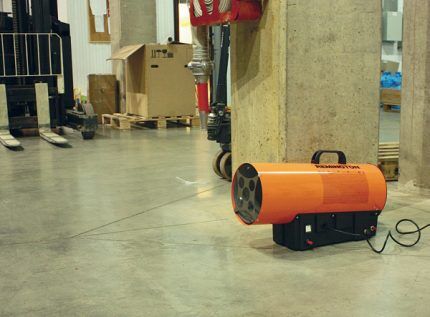
When choosing a model, it is important to consider the cost of the device itself, the price of fuel, as well as environmental safety.
Features of gas heat guns
Gas guns are often used not only in industry, but also in everyday life, for example, for heating country houses or garages. Such devices are inferior to electric ones in terms of mobility, but are more economical. In addition, such devices have quite high power, which can reach 140 kW.
Heaters can run on natural or liquefied gas, but they also need access to electrical networks, since the operation of the fan, thermostat and other components is impossible without electricity.
Various modifications of natural gas can be used to operate gas heat guns:
- blue fuel passing through highways;
- butane or propane in specialized cylinders.
High-power models can be connected to the gas pipeline with a special hose, which ensures their continuous operation. It should be noted that such units are usually stationary, since their movement is somewhat difficult.
Compact mobile devices operate on bottled fuel. In some cases, the gun is connected by a hose to a large cylinder, which stands motionless. In others, a small gas tank is an element of the unit’s design.
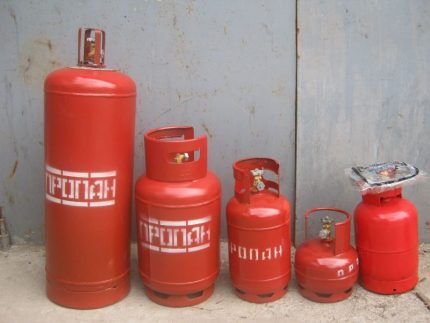
Many modern models of gas heat guns provide additional functions, for example, protection of the housing from overheating, automatic shutdown of the device, and flame control.
Additional information about the design and various modifications of gas guns is given in this article.
Making a gas heat gun with your own hands
First of all, we emphasize that only craftsmen with extensive experience and proper qualifications can undertake the independent production of gas heat guns.

If you are confident in your abilities, then you can start working by selecting the necessary devices and materials.
List of tools and materials
To make your own gas heat gun you will need:
- a metal pipe through which fuel will be supplied to the system;
- Bulgarian;
- steel sheet;
- drill with drill bits for working on metal;
- metal strips (thickness 2 mm);
- 8 mm steel tube for the heat exchanger;
- fittings for the stand on which the gun will be placed;
- fan with a minimum power of 12 volts.
You may also need other equipment, such as a pipe welder.
Step-by-step instructions for making the device
First of all, you should take care of the body. It can be made from an ordinary pipe or a casing can be made from a sheet of steel of medium thickness. The metal must be cut, giving it the required parameters, and then rolled into a pipe.The edges are fastened using the connecting lock method or ordinary bolts.
Then you need to use a grinder to cut the tube intended for conducting gas into the system. This is necessary in order to further lengthen this element by welding to it the same part with a similar diameter.
Next, you need to slightly expand the hole through which the gas will flow, bringing it to 5 mm.
To increase heat transfer, it is also advisable to lengthen the body using a metal disk with a diameter of 8 cm, which is fixed under the burner. Eight holes with a diameter of 1 cm should be drilled on it, which ensures easy access of air.
After this, you should start making a clamp with which the heat exchanger will be fixed.
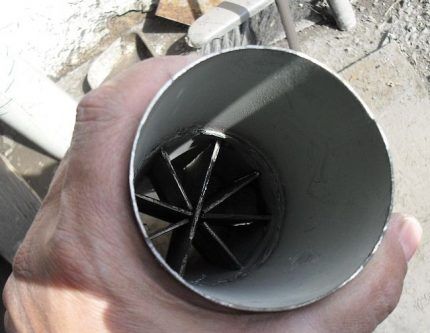
Next, you can begin manufacturing the heat exchanger. To do this, you should take an iron pipe with a diameter of 8 cm, which has not too thick walls. We weld the end to the wall, where you also need to drill a hole.
An extension cord from the burner is passed through this part, while the clamp located at the end is additionally strengthened with bolts.
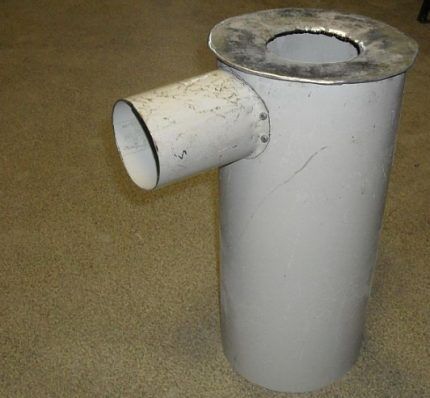
You should also start assembling all the burner parts, and install a switch for the fan into the heat exchanger housing.
In the body of the thermal energy exchanger, it is necessary to make a hole using a grinder, to which the cut part of the 80 mm tube is attached.It will serve to release heated air.
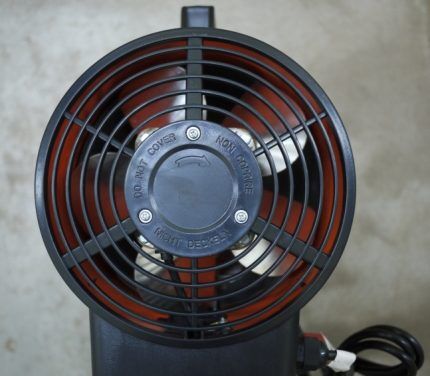
After this, you can proceed to installing a fan at the second end of the heat exchanger. Through this part, heated air will be transferred to the cold space. It is also necessary to consider the energy source for the fan. As a rule, it is connected to the mains, but it is possible to use a battery.
The final stage of making a homemade cannon is drilling the holes necessary for convenient ignition of gas.
It is also important to consider the design on which the gas gun body will be installed. You can take a ready-made suitable stand or use the iron reinforcement from which the frame is made.
To accurately regulate the air flow, it is advisable to install a limiter on the heat gun. A damper located between the fan or mounting flanges can be used.
How to do a test run
After assembling the structure, it should be connected to a pre-prepared gas cylinder using a tube.
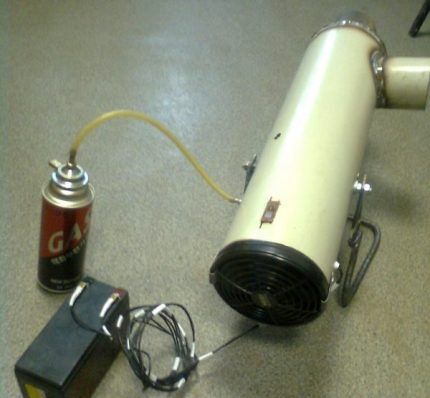
In order to check the assembled structure, it should be tested:
- a lit lighter is brought to the ignition hole;
- the valve opens to provide gas access;
- immediately after the fire appears, the lighter is hidden;
- The fan on the device turns on.
If assembled correctly, the gas burner will burn evenly and release heat immediately. A similar algorithm of actions should be used the next time the device is turned on.
Popular models of factory gas heat guns
If it is not possible to make a gas heater yourself, you can study the modern market of heating appliances and choose the best option.
Some of the most popular companies producing gas heaters include companies such as:
- Ballu;
- Fubag;
- Neoclima;
- Master;
- Resanta;
- Interskol.
According to a survey conducted among users of specialized forums, the following models made it to the top: MASTER BLP 17M, Neoclima IPG 15, Interskol TPG-15.
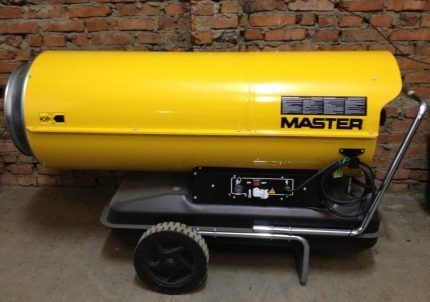
MASTER BLP 17M. The unit has an adjustable power of 10-16 kW, making it possible to maintain a comfortable temperature in a room with a volume of up to 655 m3.
Power is supplied by connecting to a gas cylinder through a reducer and connecting to a household electrical outlet. Mechanical ignition causes some inconvenience.
Neoclima IPG 15. A device with a power of 18 kW is capable of heating a room measuring 400 m3, while the fuel consumption is 1.4 kg/h. The model also includes a hose and a gas reducer.
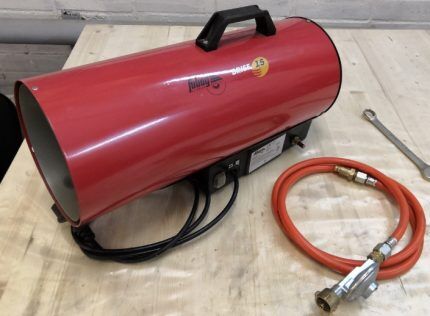
Interskol TPG-15. Unit with a capacity of 300 m3 per hour, the power of which can be changed within 3-15 kW, while fuel consumption will vary from 0.73 to 1.3 kg/h. Such a device can operate on both propane and butane.
Safety rules during operation
Heat devices, including gas devices, are fire hazardous equipment that requires strict adherence to safety regulations.
First of all, you should familiarize yourself with the regulatory documents relating to regulations for working with gas equipment, namely GOST R ISO 11439-2010 for working with gas cylinders and GOST 17356-89 (burners using gaseous fuels).
Requirements for the use of devices:
- Gas heat guns should not be left unattended, especially for homemade appliances. Factory models often have an emergency shutdown function, for example, when the outer shell heats up.
- It is not advisable to keep flammable substances in a room heated with such devices. As a last resort, they should be stored as far away from the device as possible.
- When operating appliances with open heating, it is necessary to ensure proper ventilation of the room. When working with a device with indirect heating, be sure to check the serviceability of the chimney and make sure that harmful exhausts flow out.
- When operating a gas heat gun, it is prohibited to use aerosol cans.
- It is not recommended to use such devices if there are very fine sawdust or other easily flammable fibers in the air. Such a device is also not suitable for heating a room in which vapors of gasoline, acetone or other flammable substances are sprayed into the air.
- The operating device must be on a flat surface, which ensures its stable position.
- Do not connect any hoses to the inlet or outlet as this may reduce air flow, resulting in a concentration of carbon monoxide and/or other harmful substances.
- A gas gun cannot be used in rooms with a high vapor content, for example, in a swimming pool, bathhouse, sauna. It is also not recommended to use it outdoors, especially in rain and snow.
- Do not cover the switched on gas device with anything, or close the opening of the device.
Before connecting to the mains, make sure that the socket is grounded, also, during operation, you cannot close the opening of the gun and cover the device itself.
It is advisable to cover the ends of the gas gun with a metal mesh. This will dissipate a powerful flow of hot air, the temperature of which can exceed +250° WITH.
Conclusions and useful video on the topic
The posted video clearly shows the process of creating a gas heating device with your own hands.

A gas heat gun is a powerful device that can heat even a large room in the shortest possible time. Such units can be purchased in specialized stores or made with your own hands.
In the latter case, one should understand the complexity and responsibility of this task, since handling gas appliances requires careful work and strict adherence to safety rules.
Do you have experience building a heat gun? Or still have questions on the topic? Please add comments, participate in discussions on the article and attach photos of your homemade products. The communication block is located below.




But this is interesting! There will be something to occupy yourself on vacation. It’s good that you didn’t forget to mention safety precautions and attached a video for clarity. For very advanced users, you can add how to install a temperature sensor that will turn off the gun if it overheats, and add a couple of sentences about the area of the room that it can warm up. And so great! I keep it for myself.
An industrial flow heat gun was used during construction in winter. They turned it on to dry the plaster on the walls, and in general to make the concrete harden faster. We connected it to propane, and in just 30 minutes the wall dried out. I think that using such equipment in a homemade manner is a little dangerous, especially if you are not a master, but if your hands are straight, then, of course, you can try, everything is described in detail here.
Egor, did the plaster crack from such high-speed drying? It seems that it is undesirable to reduce the time for the solution to harden. At least the floor screed in such conditions will definitely crack.
Of course it was cracked, it couldn’t have been otherwise. A heat gun is used to maintain a favorable temperature at which drying proceeds faster, but it is strictly contraindicated to direct its air flow to the plaster.